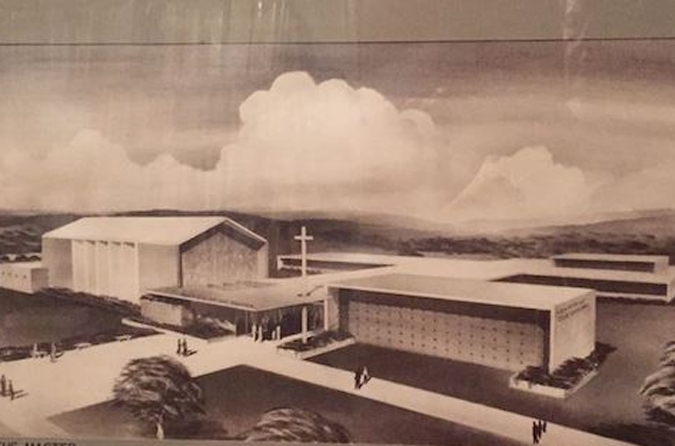
That didn’t take long. On the heels of yesterday’s news that the Meadows Building off Central Expressway may be “amputated” comes word of yet another historic Dallas structure staring down the bulldozers. Candy’s Dirt reports that the owner of the former Church of the Master, Evangelical and Reformed Church in Oak Cliff, near the corner of Kiest and Polk, wants to rezone the land and tear down the building, replacing it with who knows what. The City Plan Commission hearing on the zoning case was supposed to be held today, but it has been pushed back to January 7.
Now, before we get all hot under the collar about this latest historic tear down, it’s worthwhile to raise the question of whether or not every old building in Dallas should be considered historic and worthy of preservation. If you cruise by the church — which sits adjacent to some run down apartments, catty corner to Barbara Jordan Elementary, and across the street from a big old strip mall that boasts a car wash and gas station — you might think it is just a decaying relic of a long departed congregation’s forgotten zeal. On top of that, it is a building that looks particularly difficult to adapt and reuse, both in terms of its design and footprint. The basic economics of the land demand a denser, more-intensive new use. And if I were a neighbor of the church, I’d likely welcome a new development that actually contributed to the services of the community, rather than a retain a mothballed monument to some urban historians’ idealism.
But this particular building does boast a particular provenance. It was designed by George Dahl, one of the most important architects in Dallas history. With a career spanning more than four decades, Dahl has perhaps designed more significant buildings in Dallas than any other single architect. His credits include the Neiman Marcus Building, the Cotton Bowl, the Esplanade of State in Fair Park, the Dallas Morning News Building, the First National Bank Tower, the Old Dallas Central Library (adjacent to the Statler), the Owen Fine Art Center at SMU, the Earle Cabell Federal Building — the list goes on and on and on.
In 1953, Dahl’s office also built this little church in Oak Cliff. Looking past its slumping neglect, you can spot the traces of his style: sleek lines, simple accents, balanced use of concrete and brick, modest economy of style and function. Like much of Dahl’s mid-century work, it’s a graceful little building. Still, comparing it with the original renderings, you can see that much of Dahls’ original church has already been torn down to make way for a parking lot and apartments. The argument can easily be made that this particular Dahl building has already been compromised beyond the point of historic reclamation.
What responsibility does a city have to its past? This is the question that swirls around all these instances of historic preservation. Sometimes the answer is obvious. If a building is particularly old or notable it should be saved. If it is simply old, perhaps not. But because Dallas has so aggressively attacked its history, each remnant of it now feels so precious and irreplaceable. We are tempted, as Candy’s Dirt urges us, towards a knee jerk response — Start the letter petition! Get out the pitch forks and head to the horseshoe on Marilla!
But I don’t think this building warrants such a staunch preservationist response. If I were handling the zoning case for this site, I may try to negotiate a conditionally rezoning, salvaging the main Dahl building and working with the developer to incorporate that structure into an imaginative new development. It would take not a small amount of creative design, and the problem is these kinds of compromises don’t always work out as intended. It only takes one glance at the idiotic re-installation of the Alamo Plaza signs that are now shoved into the dirt at Sylvan Thirty to realize that sometimes an attempt at preserving the past is not much more than pointless sham. Less a monument to what was, those signs now strike me as a giant middle finger to the community Sylvan Thirty moved into.
What this particular case illustrates is the pressing need for more subtly and clarity when it comes to historic preservation, both in terms of how we craft policy around preservation and how we articulate our values and intent for preserving this city’s history. Dallas still doesn’t have policy tools that can deal with the subtle complexities that Dallas’ particular historic architecture presents. The demolition delay ordinance was little more than a public demonstration of a general appreciation of the importance this city’s history. It was not the end of the work of the Mayor’s preservation task force, it just marks the very beginning. The frequency with which Dallas’ historic buildings are being threatened, thanks to a welcomed economic boom in the city center, makes continuing the work of crafting a set of real historic preservation policies and tools all the more pressing.





